Behaviour-Driven Development for better software products
31 May 2021
We need to minimize friction due to misunderstandings between software development and software specification teams, proposing an innovative approach for software specification. This one should facilitate the common understanding and encourage each stakeholder’s accountability, product person, software engineer, test engineer, in the quality of the delivered increments.
Structure
- The first part sets the current context with the traditional approach based on the usual agile tools and roles, illustrating some issues and suggesting remedies.
- The second part outlines Behaviour-Driven Development (BDD) as a recognised software crafting technique that can address the issues listed.
- The third part explains the concrete implementation of this technique.
- The fourth part provides immediately usable material for trying it out.
Context
Traditional approach
Backlog building
The product owner listens to customer needs, he owns and manages a product backlog composed of features that extend the current product capabilities or current system behaviour.

Features understanding
The product owner explains the expected system behaviour to software and test engineers; they try to align their mental representation with the product owner’s one challenging him with their perspective during backlog grooming or feature kick-off sessions.
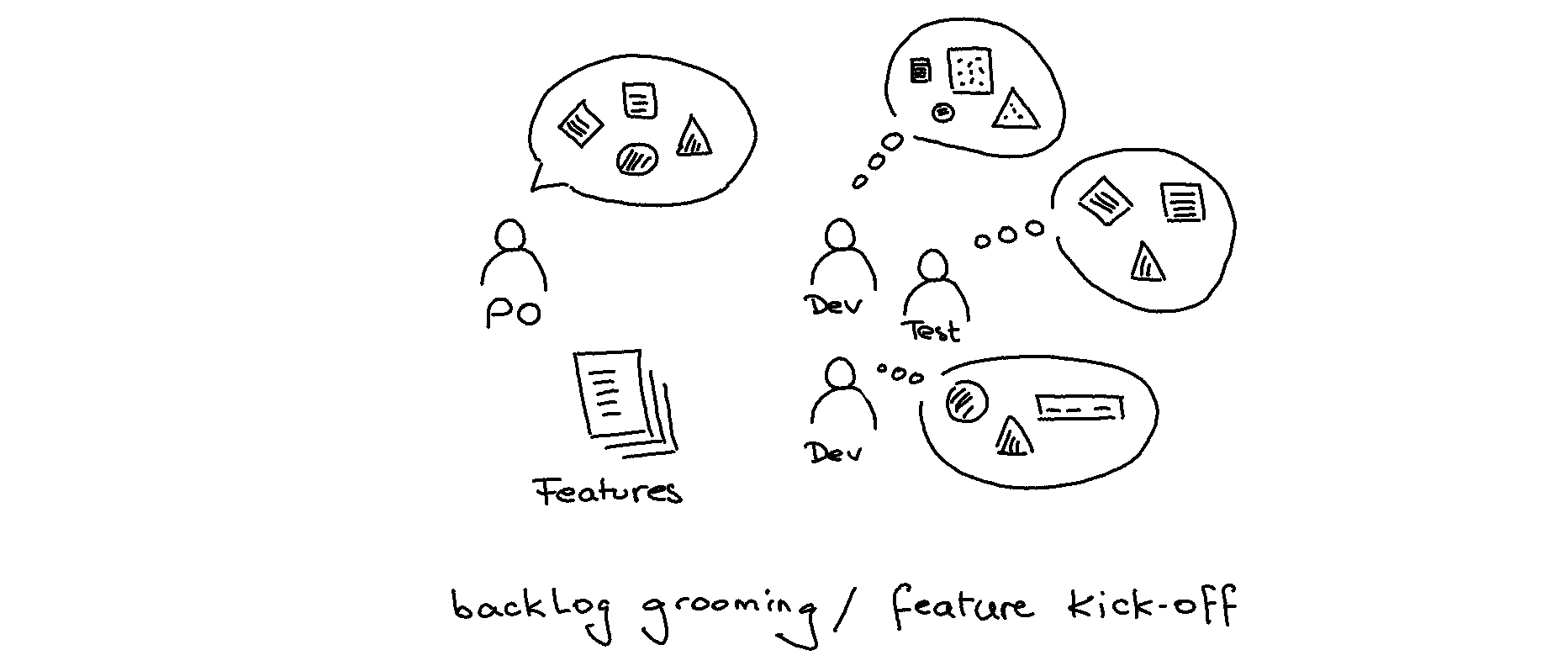
Software delivery
Every delivered functional increment is verified by the test engineer; he checks the completeness and the correctness, and with the best effort, the absence of regression. Anomalies are returned to the development team for the next delivery.
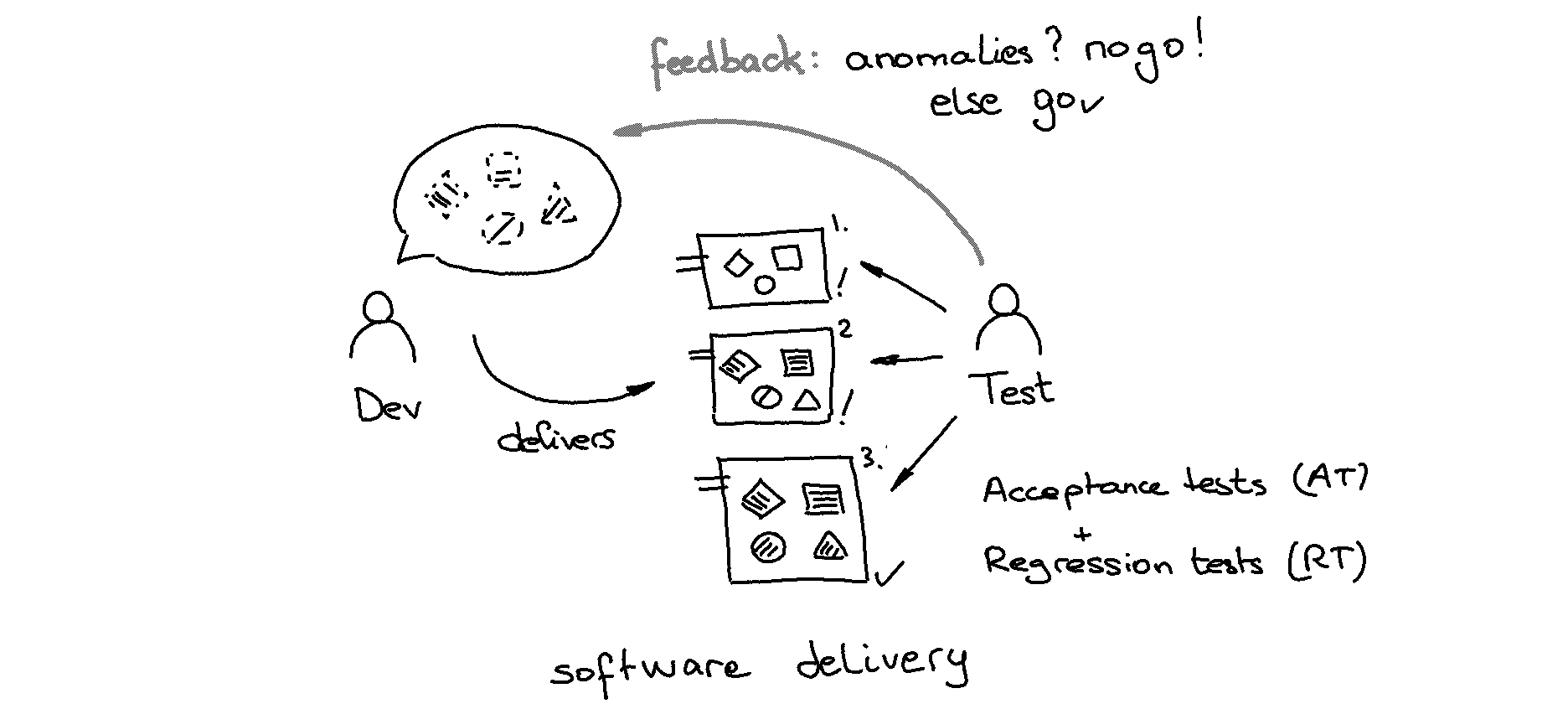
Some weaknesses and remedies
Anomalies
Anomalies due to misalignments or lack of quality in the realisation can cause time-consuming ping-pong loops.
Could an innovative approach that re-establishes a contractual element encourage greater accountability of each stakeholder for the quality of delivery?

Cost of regression tests
The testing activity usually focuses on checking newly added features and regressions. Regression testing activity is time-consuming and should be automatized, or unfortunately, may be shortened to well-selected tests.
Could we innovate on the tester’s activity by automating it and giving him more impact upstream?
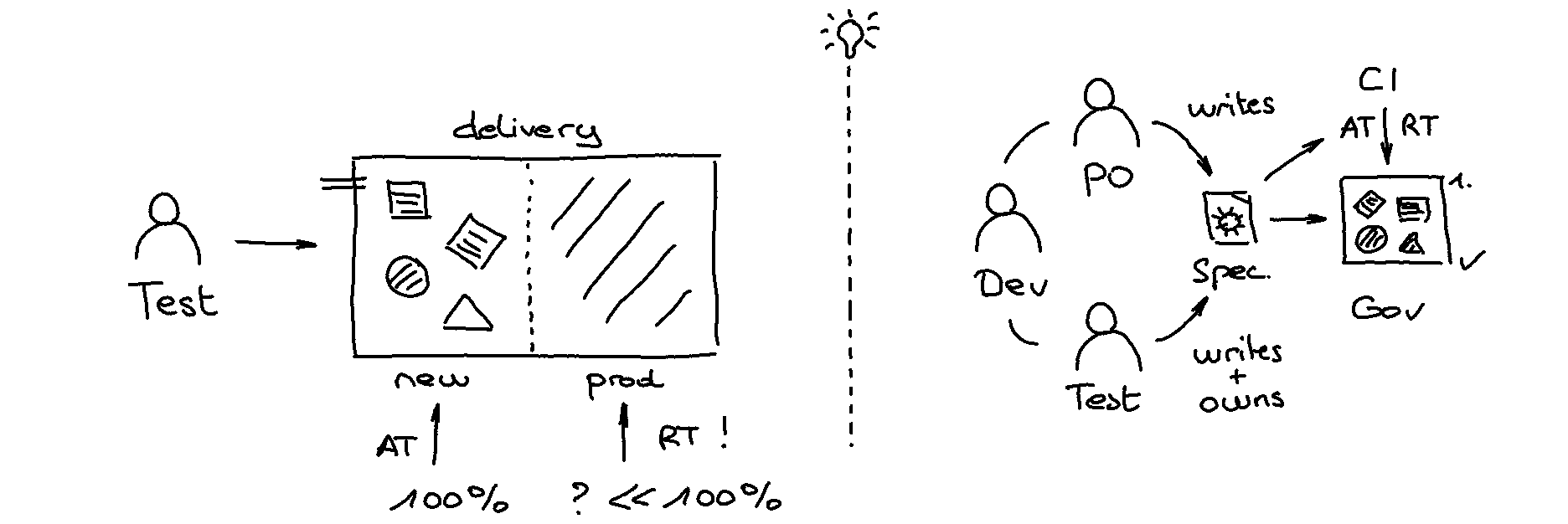
Loss of trust
Anomalies, regressions, misalignments can have a bad impact on the already established trust towards the product itself, outside or even inside the product team.
Could a collaborative approach that promotes shared accountability, transparency and regular feedback during implementation build trust?
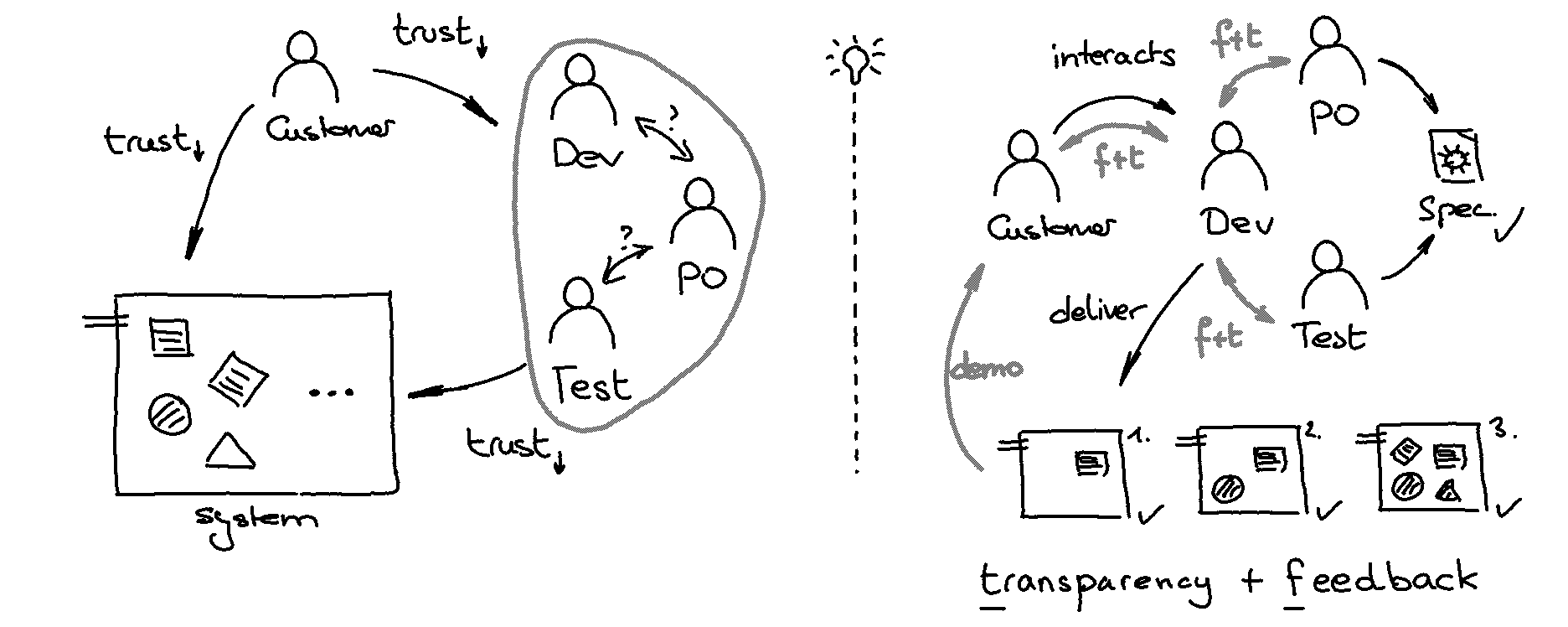
Tunnel effect
The absence of testable delivery for a couple of time means less feedback, hence less opportunity to react to any misalignment.
Could the division of a feature into several deliverables containing one or more scenarios facilitate deliveries and thus feedback possibilities?
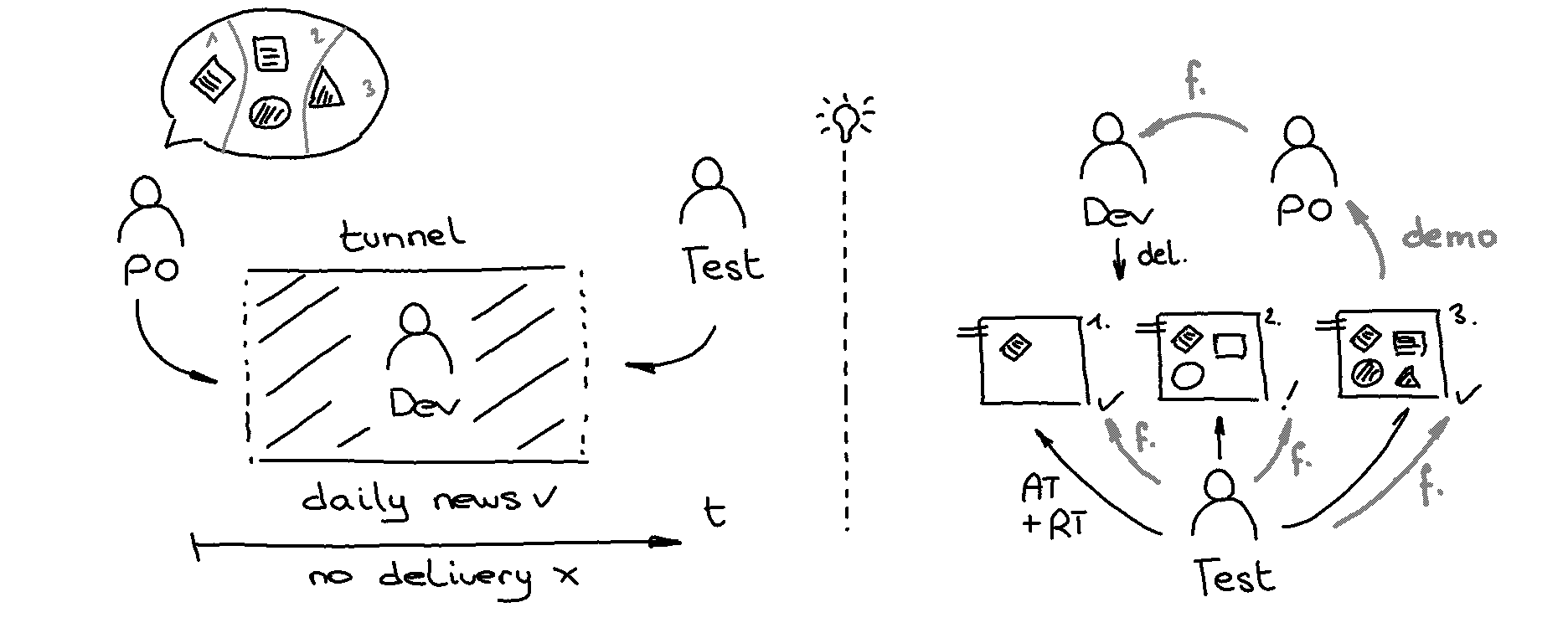
Lack of documentation
What does the system solve? What are the features? What are the nominal and edge scenarios? What about testing evidence?
Agile software development manifesto aims to privilege working software over comprehensive documentation. Therefore, the sources of documentation about what the developed system solves are production code, test code and mental and often distributed knowledge. Consequently, more pressure is put on well-crafted code. In addition, narrative sources of documentation can still be valuable for setting the context, but they are usually written at a high level and may no longer be aligned with the behaviour of the completed system.
Could a collaborative approach restore a lightweight, human-readable digital artefact that contractually formalises common understanding and be a source of living documentation that provides features and testing evidence?

BDD
Behaviour-Driven Development (BDD) is a software development technique with the main promise to facilitate shared understanding and optimise software deliveries’ functional quality.

Secure software development
This technique helps to develop securely the right thing, which is the expected system behaviour, and without causing functional regression.
Contract-driven
This technique proposes a context for collaborative specification which aims to establish shared understanding of the expected system behaviour, and formalising this latter as a readable contractual and executable specification on which acceptance tests can be defined.
Domain-driven
The issued specification artefact uses a natural language based on the domain language which is naturally understandable by every stakeholder: product person, software and test engineers.
Documentation-driven
This artefact written with Gherkin syntax explains the system behaviour based on examples grouped in scenarios that describe the system use cases and the business rules.
Here is an example that uses a generic scenario to describe the behaviour of a calculation function; the Examples section defines the input and output values:
Rule: The stress amplitude is the ratio between shock values of two stress driver shocks.
Scenario Outline: Return expected stress amplitude for compatible shock types
Given a stress shock
| driver-key | shock-type | shock-value |
| <driver-key> | <shock-type> | <shock-value> |
And another stress shock
| driver-key | shock-type | shock-value |
| <driver-key> | <ref-shock-type> | <ref-shock-value> |
When calculating amplitude
Then the returned amplitude is <amplitude>
Examples:
| driver-key | shock-type | shock-value | ref-shock-type | ref-shock-value | amplitude |
| Equity-USA | RELATIVE | 0.15 | RELATIVE | 0.10 | 1.5 |
| Equity-USA | RELATIVE | 0.25 | RELATIVE | 0.10 | 2.5 |
| Equity-USA | RELATIVE | -0.15 | RELATIVE | 0.10 | -1.5 |
| Equity-USA | ABSOLUTE | 3 | ABSOLUTE | 2 | 1.5 |
| Equity-USA | ABSOLUTE | 2 | ABSOLUTE | 3 | 0.6667 |
| Equity-USA | ABSOLUTE | 2 | RELATIVE | 0.10 | - |
| Equity-USA | RELATIVE | 0.15 | ABSOLUTE | 2 | - |
| Equity-USA | RELATIVE | 0.15 | RELATIVE | 0 | - |
| Equity-USA | ABSOLUTE | 2 | ABSOLUTE | 0 | - |
More BDD scenarios: Blueprint API (Kotlin),
Test-driven
Coupled with Acceptance Test-Driven Development (ATDD), an outside-in software development technique, the software engineer automates the test cases and can be driven to the completeness, correctness, and the absence of functional regression when developing a feature increment.
BDD was originally named in 2003 by Dan North as a response to test-driven development (TDD), including acceptance test or customer test-driven development practices as found in extreme programming.
BDD in practice
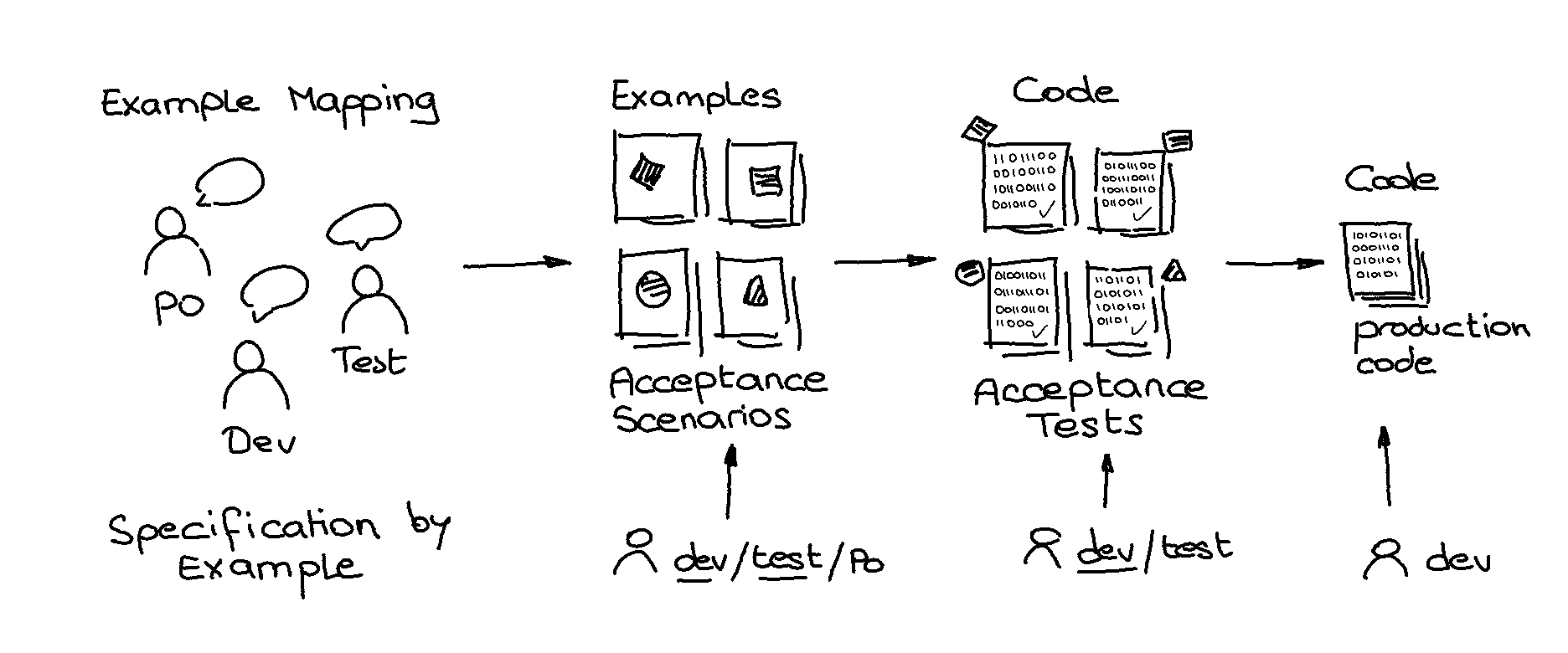
Specification by example activity facilitates a common understanding of expected behaviour based on examples. It applies to a large set of use cases of any domain: calculation, aggregation, orchestration, eventing, management, workflow.
- Specification by example activity is done during Example Mapping sessions.
- Formalisation of expected system behaviour is done with acceptance scenarios expressed with domain language and formalized with Gherkin syntax.
- It requires practice; finding good wording have to be learned by doing; efficient wording can be easily understood, can be validated, and can be automatized.
- Automatization means the development of automatized acceptance tests enabled by using glue code.
- Development of production code is then driven by existing acceptance tests (ATDD).
Three amigos
The conversations in the Specification by Example activity are the result of the interaction of three actors with different perspectives, brought together for the same purpose: Product person or domain expert, software engineer, and test engineer.
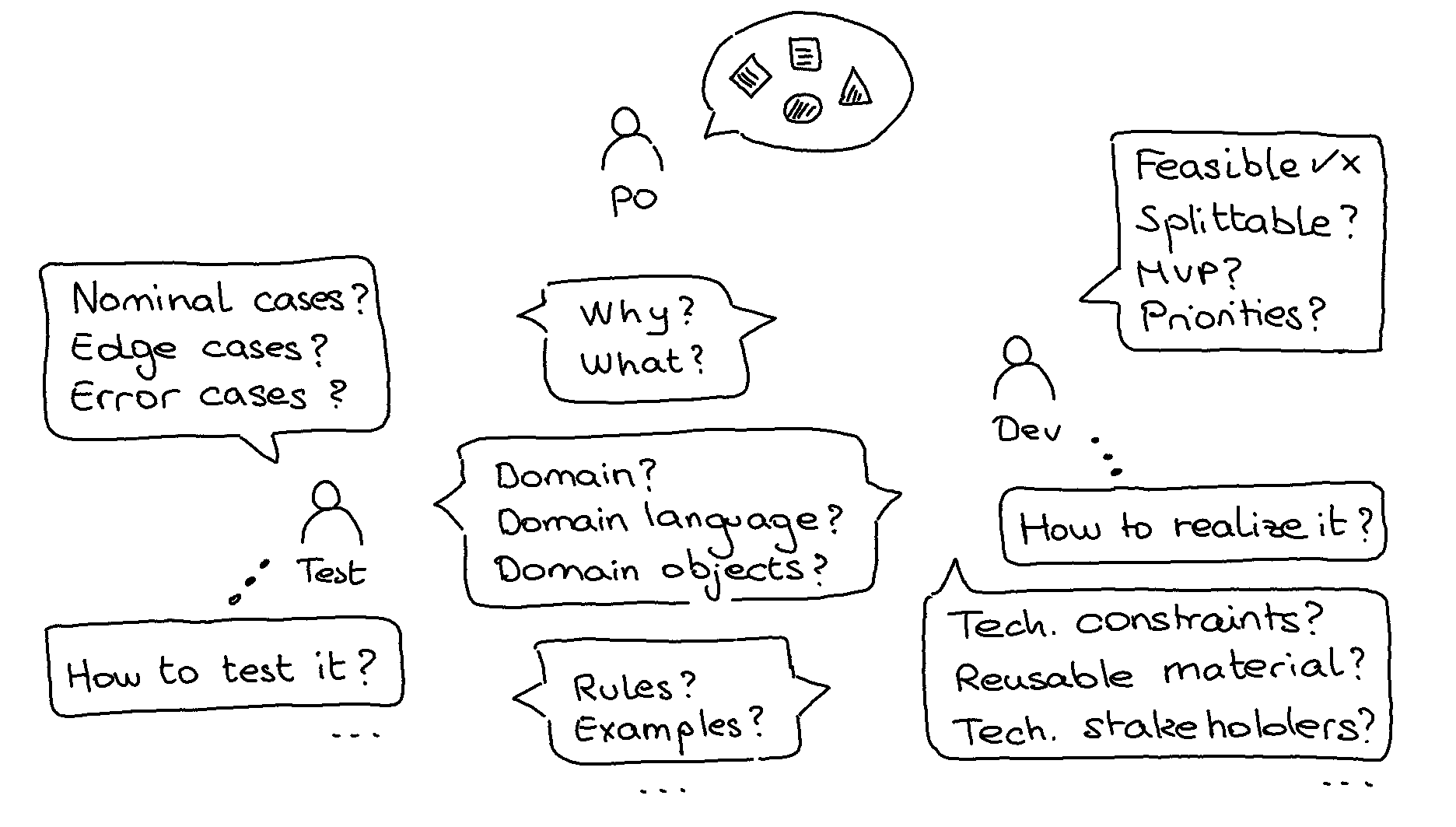
The Product person should be the product owner; the Domain expert (business analyst, domain architect, or business owner) can be a substitute of the Product person; the Customer can be an optional stakeholder.
Example mapping
An Example mapping session facilitates structured conversations between the three amigos.
It allows identifying user stories, open questions, business rules, and examples.
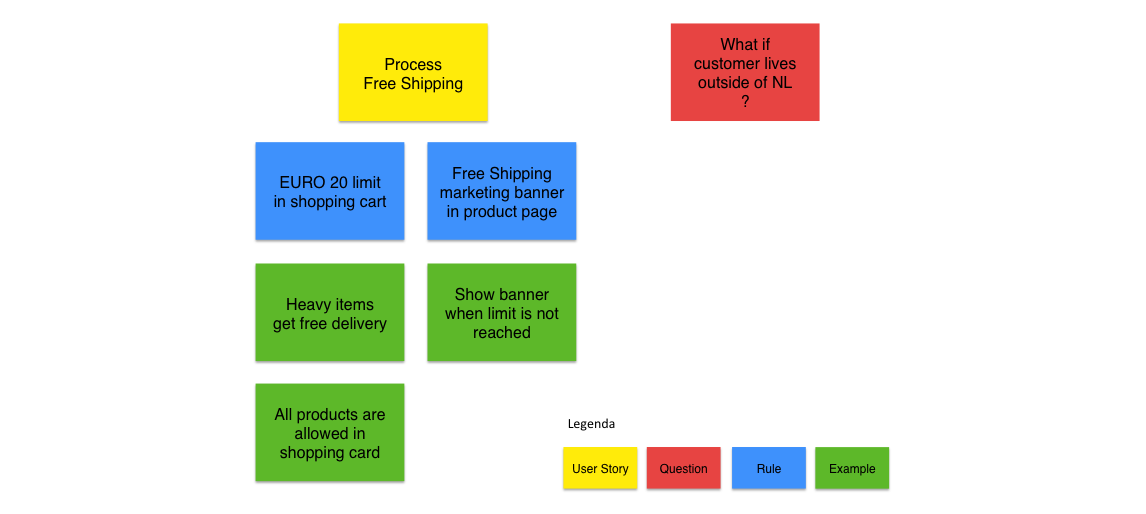
Feature, story, business rule, scenario, example
- One feature is explained by one or more scenarios grouped in stories.
- One story usually groups one or more scenarios and represents a feature increment with business value.
- One business rule is usually supported by one or more scenarios or examples.
- One scenario is supported by one or more examples.
- One scenario by nominal case.
- One scenario by edge case.
- One scenario by negative or error case.
Scenarios writing
Writing scenarios helps to build up the common ubiquitous language in a way that everyone can understand and validate.
As it requires some experience and a particular way of thinking, it is recommended to let this activity to the test engineer or the software engineer. Feedback by the Product person can be done once they have drafted the Gherkin specification.
A scenario is composed of a set of preconditions about the initial state or context, then a set of actions (usually one), then a set of assertions (or postconditions) about the final state or context.
Feature: To be able to manage a set of existing clients in a persistent way
Background:
Given a following set of existing clients
| model-id | id | name | internal | prospect | owners | tags | creation-date |
| 1 | ce751f30-217a-422c-b81b-8f75df4917b6 | client1 | true | false | x | key1:a | 2020-10-10T12:00:00 |
| 2 | 29e364b9-f5ef-43d9-9f30-e07a30b73e01 | client2 | true | true | - | - | 2020-10-09T12:00:00 |
Rule: An existing client is a persisted resource in the system.
Scenario: Add a new client to the existing clients
Given a following set of client attributes
| name | prospect | owners | tags |
| test | true | owner1 | key:test,key1:a |
And the next identifier is afd9ce9f-ee0e-4547-8c77-3cc43ec85dbc
And the next timestamp is 2020-10-11T12:00:00
When registering the new client
Then the response status is CREATED
And the attributes of the returned client are the following
| id | name | prospect | owners | tags | creation-date |
| afd9ce9f-ee0e-4547-8c77-3cc43ec85dbc | test | true | owner1 | key:test,key1:a | 2020-10-11T12:00:00 |
And the returned client is added to the set of existing clients
And no export of the configuration has been triggered
And a Slack notification has been sent
More BDD scenarios: Blueprint API (Kotlin),
Scenarios validation
Every scenario has to be validated by every stakeholder or amigo, that it describes an expected facet of the system behaviour. As a result, shared understanding is materialized into a digital set of acceptance scenarios that establish a contract between all stakeholders.
These acceptance scenarios are the foundation of an executable specification and the building blocks for the definition of acceptance tests.
Acceptance testing
Acceptance tests support high-level functional testing which includes testing of new feature increment and regression testing.
This activity is usually done by a test engineer of a quality insurance team to validate a delivered feature increment before its deployment to production.
Non-functional requirements could be tested by specific acceptance tests.
ATDD
ATDD is a test-driven development technique based on acceptance tests used by the software engineer for driving its development to the expected system behaviour.
Given an acceptance scenario, a failing acceptance test is written first, then the software engineer writes the minimal production code to make it pass. This action is repeated with a next acceptance scenario, coupled with a refactoring phase applied to both test and production code, to take care of well-crafted code and design.
This cycle executed at the feature level contains an inner TDD cycle performed at the component level, this technique is named Outside-in TDD.
BDD and ATDD
ATDD is used with BDD to automate acceptance scenarios: one scenario gives one acceptance test.
BDD glue code, test code, and production code
- Test code implements acceptance tests and interacts with the production code.
- BDD glue code implements the mapping of BDD steps writen in natural language into test code.
- BDD steps are mapped by BDD glue code into test code writen in a given technology.
- BDD framework (Cucumber, Behave) traverses the steps and automatizes the execution of the test code.

@Given("a stress shock") // glue code
fun oneShock(shock: List<TestShock>) { // glue code
// test code: fixture
ctx.put("one-stress-shock", shock.first())
}
@Given("another stress shock") // glue code
fun anotherShock(shock: List<TestShock>) { // glue code
// test code: fixture
ctx.put("other-stress-shock", shock.first())
}
@When("calculating amplitude") // glue code
fun calculateAmplitude() { // glue code
// test code: action
val one: TestShock = ctx.byId("one-stress-shock")
val other: TestShock = ctx.byId("other-stress-shock")
runCatching {
AmplitudeComputer().compute(one.toShock(), other.toShock()) // production code
}.getOrNull()
?.let { ctx.put("result-amplitude", it) }
}
@Then("the returned amplitude is {word}") // glue code
fun returnedAmplitudeValueIs(expected: String) { // glue code
// test code: assertion
val resultAmplitude: Double? = ctx.byIdOpt("result-amplitude")
val expectedAmplitude = expected.toNullable()?.toDouble()
if (resultAmplitude != null)
assertThat(resultAmplitude).isCloseTo(expectedAmplitude, offset(0.001))
else
assertThat(expectedAmplitude).isNull()
}
BDD with acceptance test, scope
Well-written BDD scenarios are done using domain language which is naturally high-level so that one scenario could be automated for targetting either a user interacting with a frontend application, or a web API, or a component that supports application logic or domain logic. A specific glue code developed for each target enables this decoupling.

Examples:
BDD with acceptance test vs xUnit tests
Acceptance tests are high-level integration tests defined at feature-level. Supported by the natural language and the Gherkin syntax, their self-documentation is accessible to every stakeholder and emphasizes the implemented and tested behaviour with its preconditions and postconditions. Acceptance tests usually cover functional requirements, and could check non-functional ones as well. Smoke tests can be supported by a subset of acceptance tests.
xUnit tests, due to their technical aspect, do not connect every stakeholder, hence do not provide evidence of which functional requirements are implemented and tested.
BDD and agility
Agile ideology influences methodologies for iterative development of small increments, enabling quick feedback and adapt.
Delivering the most valuable scenarios inside one or more stories has a natural priority, then further valuable set of scenarios can be delivered in other increments.
Scenarios are developed against single acceptance tests which can be executed by a continuous integration tool. This tooling can be configured to monitor which scenarios have been delivered and which ones are still under development. This promotes transparency and enables feedback, early reaction, and prediction towards the deadline.
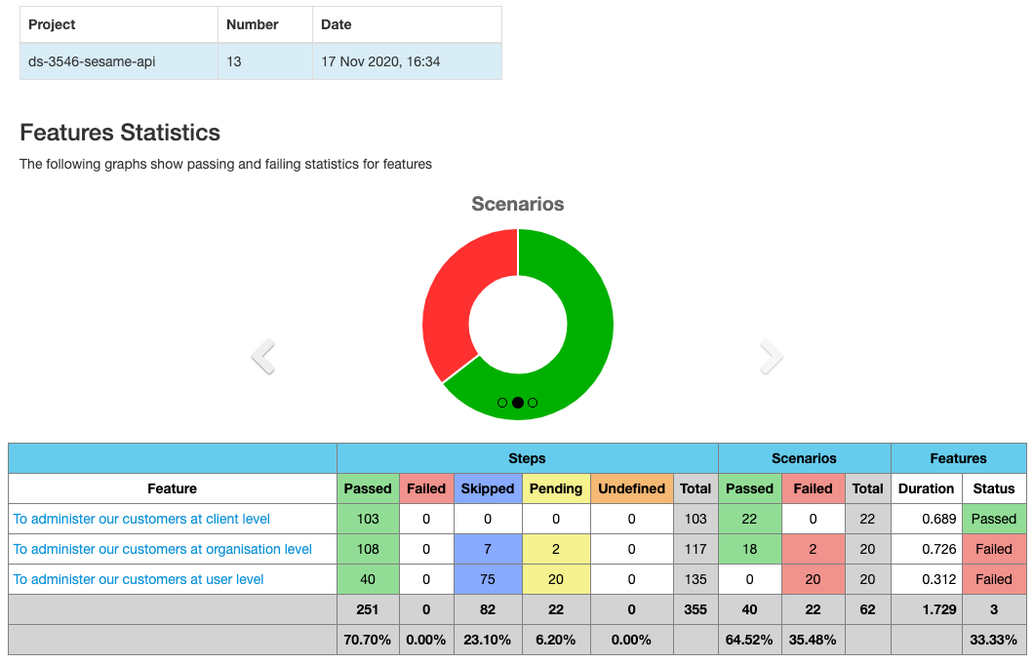
Living documentation
Living documentation is made possible based on BDD-driven specification with tooling provided by Serenity-BDD.
Evidence of system well-being
-
With Serenity-BDD test execution reports tooling, proof of evidence can be provided to auditors that all requirements covered by the system in place are supported by documented and continuous acceptance tests. It supports Java technology only.
-
With Allure test execution reports tooling, more evidence can be provided to auditors that testing is done in-depth, even at the lower levels of the test pyramid i.e component integration testing and component unit testing, and uniformly for a couple of technologies (Python/Go/Java/Kotlin).
Summary
Outcomes
- Common understanding of expected system behaviour expressed in a domain-oriented ubiquitous language.
- Enhanced probability that the implemented thing is the right one.
- Human-readable, contractual and executable specification directly useable by every actor of the development team.
- Scenario-based, use-case-driven and domain-driven documentation of system behaviour.
- Scenario-based organization and survey of feature development.
- Innovation brought to the tester role, the test engineer can now have a significant impact on the development.
Costs
- Time: to attend, organize and facilitate Example mapping meetings
- Time: to learn one new technique
- Time: to learn how to write BDD-scenarios
- Time: to setup a BDD-framework
- Time: to craft reusable glue code and test code
- Time + Money: to maintain Gherkin phrasing, glue code and test code
This technique should reveal itself as a sustainable investment in product quality.
BDD material
Technical setup
Ready to use blueprints are available as BDD starters for some technology stack:
- Java BDD blueprint (Cucumber)
- Kotlin BDD blueprint (Cucumber)
